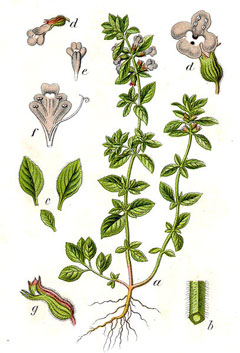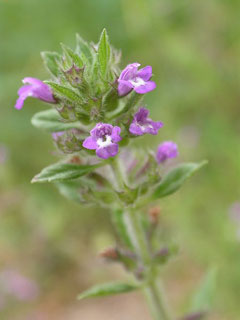 |
|
|
 |
| http://commons.wikimedia.org/wiki/User:Pichard |
Translate this page:
Summary
Physical Characteristics

 Acinos arvensis is a ANNUAL/PERENNIAL growing to 0.2 m (0ft 8in) by 0.3 m (1ft).
Acinos arvensis is a ANNUAL/PERENNIAL growing to 0.2 m (0ft 8in) by 0.3 m (1ft).
See above for USDA hardiness. It is hardy to UK zone 4 and is not frost tender. It is in flower from July to August, and the seeds ripen from August to September. The species is hermaphrodite (has both male and female organs) and is pollinated by Bees. The plant is self-fertile.
Suitable for: light (sandy) and medium (loamy) soils, prefers well-drained soil and can grow in nutritionally poor soil. Suitable pH: mildly acid, neutral and basic (mildly alkaline) soils and can grow in very alkaline soils.
It cannot grow in the shade. It prefers dry or moist soil.
UK Hardiness Map
US Hardiness Map
Synonyms
A. thymoides. Calamintha acinos. Satureia acinos.
Plant Habitats
Ground Cover; Cultivated Beds;
Edible Uses
Edible Parts: Leaves
Edible Uses: Condiment
The flowering tops are used as a flavouring[4, 177, 183] and in salads[238]. Said to be similar to thyme in odour but milder and more pleasant[183]. The plant is only faintly aromatic and does not really make a very good substitute for thyme[238, K].
References More on Edible Uses
Medicinal Uses
Plants For A Future can not take any responsibility for any adverse effects from the use of plants. Always seek advice from a professional before using a plant medicinally.
Diuretic Odontalgic Rubefacient Stomachic
Basil thyme was a great favourite of the ancient herbalists, though it is little used medicinally at present[4]. The herb is diuretic, odontalgic, rubefacient and stomachic[4, 61, 238]. The essential oil has been applied externally as a rubefacient, whilst one drop of it put into a decayed tooth is said to alleviate the pain[4]. The plant has also been added to bath water, especially for children, and is said to be a strengthener and nerve soother[4]. The flowering plant is harvested in the summer and is normally used fresh in infusions[238].
References More on Medicinal Uses
The Bookshop: Edible Plant Books
Our Latest books on Perennial Plants For Food Forests and Permaculture Gardens in paperback or digital formats.

Edible Tropical Plants
Food Forest Plants for Hotter Conditions: 250+ Plants For Tropical Food Forests & Permaculture Gardens.
More

Edible Temperate Plants
Plants for Your Food Forest: 500 Plants for Temperate Food Forests & Permaculture Gardens.
More

More Books
PFAF have eight books available in paperback and digital formats. Browse the shop for more information.
Shop Now
Other Uses
The plant makes a good ground cover[244].
Special Uses
Ground cover
References More on Other Uses
Cultivation details
Succeeds in any well-drained soil[244], though it prefers a light well-drained dry soil in full sun[1, 238]. Prefers sandy and alkaline growing conditions[238]. Dislikes shade. A very hardy plant, tolerating temperatures down to at least -15°c[238]. A short-lived perennial, but the plants usually self-sow when they are growing in a suitable position[238].
References Carbon Farming Information and Carbon Sequestration Information
Temperature Converter
Type a value in the Celsius field to convert the value to Fahrenheit:
Fahrenheit:
The PFAF Bookshop
Plants For A Future have a number of books available in paperback and digital form. Book titles include Edible Plants, Edible Perennials, Edible Trees,Edible Shrubs, Woodland Gardening, and Temperate Food Forest Plants. Our new book is Food Forest Plants For Hotter Conditions (Tropical and Sub-Tropical).
Shop Now
Plant Propagation
Seed - sow early spring in a cold frame. If you have sufficient seed then you could try sowing in situ in April or May. Germination should take place within a month. When large enough to handle, prick the seedlings out into individual pots and plant them out in the summer. Division in spring. Basal cuttings in late spring. Very easy[K].
Other Names
If available other names are mentioned here
Native Range
TEMPERATE ASIA: Iran (north), Turkey, Russian Federation-Ciscaucasia (Ciscaucasia), Azerbaijan, Russian Federation-Western Siberia (Western Siberia) EUROPE: Denmark, Finland, United Kingdom, Ireland, Norway, Sweden, Austria, Belgium, Switzerland, Czech Republic, Germany, Netherlands, Poland, Slovakia, Russian Federation (European part), Belarus, Estonia, Lithuania, Latvia, Ukraine (incl. Krym), Former Yugoslavia, Albania, Bulgaria, Greece, Italy (incl. Sardinia, Sicily), Romania, Spain (incl. Baleares), France (incl. Corsica), Portugal
Weed Potential
Right plant wrong place. We are currently updating this section.
Please note that a plant may be invasive in one area but may not in your area so it's worth checking.
Conservation Status
IUCN Red List of Threatened Plants Status :

Growth: S = slow M = medium F = fast. Soil: L = light (sandy) M = medium H = heavy (clay). pH: A = acid N = neutral B = basic (alkaline). Shade: F = full shade S = semi-shade N = no shade. Moisture: D = dry M = Moist We = wet Wa = water.
Now available:
Food Forest Plants for Mediterranean Conditions
350+ Perennial Plants For Mediterranean and Drier Food Forests and Permaculture Gardens.
[Paperback and eBook]
This is the third in Plants For A Future's series of plant guides for food forests tailored to
specific climate zones. Following volumes on temperate and tropical ecosystems, this book focuses
on species suited to Mediterranean conditions—regions with hot, dry summers and cool, wet winters,
often facing the added challenge of climate change.
Read More
Expert comment
Author
(Lam.)Dandy.
Botanical References
17200
Links / References
For a list of references used on this page please go here
Readers comment
| Add a comment |
|
If you have important information about this plant that may help other users please add a comment or link below. Only comments or links that are felt to be directly relevant to a plant will be included. If you think a comment/link or information contained on this page is inaccurate or misleading we would welcome your feedback at [email protected]. If you have questions about a plant please use the Forum on this website as we do not have the resources to answer questions ourselves.
* Please note: the comments by website users are not necessarily those held by PFAF and may give misleading or inaccurate information.
To leave a comment please Register or login here All comments need to be approved so will not appear immediately.
|
Subject : Acinos arvensis
|
|
|
|